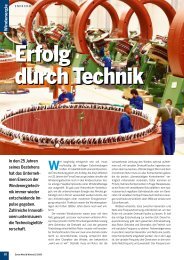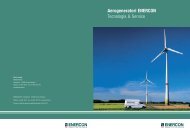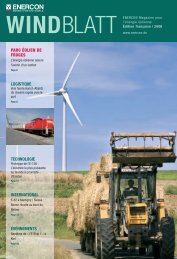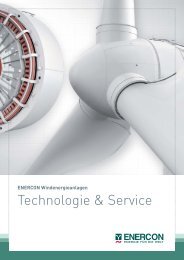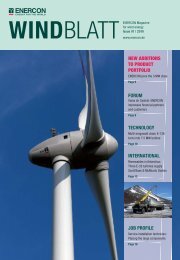Download - Enercon
Download - Enercon
Download - Enercon
You also want an ePaper? Increase the reach of your titles
YUMPU automatically turns print PDFs into web optimized ePapers that Google loves.
McMurdo station located at the base of Crater Hill, Scott Base right of the road. The wind farm will be installed on the incline to the right of the buildings on the high plane.<br />
improvements will complement the addition<br />
of renewable energy.”<br />
Building the foundations on Crater Hill (named<br />
after the volcanic crater nearby) will be<br />
a challenge. “The permafrost layer begins at<br />
only 45 centimetres below the surface”,<br />
Cornelius reports. Due to the cold, conventional<br />
concrete foundations would not harden<br />
properly. “That is why Meridian had a<br />
steel construction with precast concrete feet<br />
made in New Zealand.” The feet were already<br />
brought to Ross Island on the supply ship<br />
The supply vessel “American Tern” lands at Ross Island only once a year.<br />
last year. Cornelius: “NSF are bringing in the<br />
rest of the material by plane so that the foundation<br />
can be completed this summer.”<br />
Construction started in November this year.<br />
Each WEC foundation consists of eight<br />
13-ton prefab concrete blocks arranged in a<br />
circle in the foundation pit, Cornelius explains.<br />
Each block is fastened to the volcanic<br />
rock with two 12-metre steel anchors,<br />
which are grouted into the permafrost layer.<br />
And finally the foundation builders bolt on<br />
an eight-arm steel construction, “a steel<br />
spider” to<br />
which the<br />
steel tower<br />
is flanged.<br />
Pictures: Meridian Energy<br />
There is a<br />
potential for<br />
even more<br />
extensive<br />
use of wind<br />
energy on<br />
Ross Island.<br />
Meridian and<br />
Antarctica<br />
New Zealand<br />
have been<br />
taking wind measurements on Crater Hill,<br />
amongst other places, since 2005. The<br />
average wind speed at the 190 metre high<br />
site is around 7.8 m/s at 37 metres hub<br />
height. In addition to Crater Hill, at least two<br />
other suitable sites have been singled out<br />
on Ross Island.<br />
The average annual temperature on Ross<br />
Island is -20° C. Even on the “warmest”<br />
days in summer, with 24 hours sun, the<br />
temperature only rises to +6° C. ENERCON’s<br />
installation team will have to bundle up.<br />
Lindeiner is not worried: “The New Zealanders<br />
will provide our guys with the appropriate<br />
cold weather gear.”<br />
Until their installation at the end of next year,<br />
the wind turbines will be kept in storage in<br />
heated containers at Scott Base. Shortly before<br />
installation next year, four engineers<br />
from Meridian will travel to Germany for four<br />
weeks of training at ENERCON’s home base<br />
in Aurich to learn the essentials of WEC installation<br />
and maintenance. These trained<br />
technicians will then be able to assist in assembling<br />
the turbines on Ross Island and later<br />
support the Service centre in Aurich with<br />
vital information.



![[PDF] WB 02-2013 deu web - Enercon](https://img.yumpu.com/23394578/1/190x253/pdf-wb-02-2013-deu-web-enercon.jpg?quality=85)
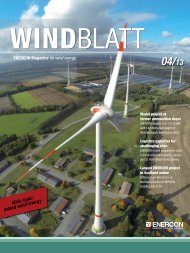

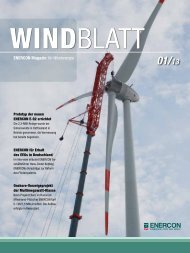
![[PDF] WB 04-2013 deu web - Enercon](https://img.yumpu.com/22304561/1/190x253/pdf-wb-04-2013-deu-web-enercon.jpg?quality=85)
